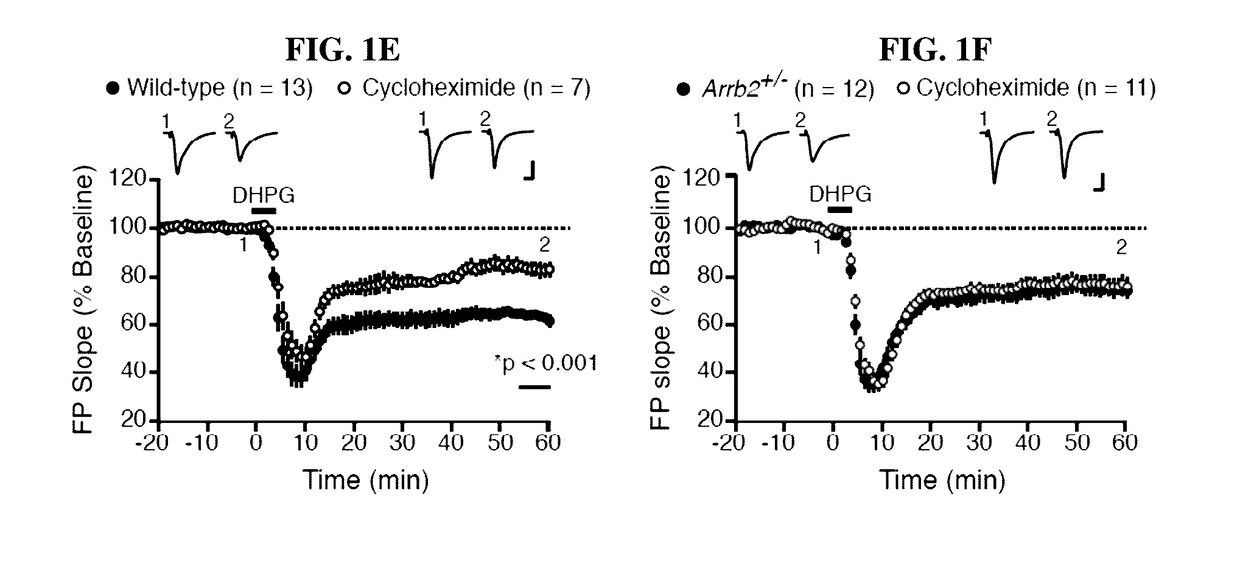Methods of treating fragile x syndrome and related disorders
a fragile x syndrome and related disorder technology, applied in the field of methods of treating fragile x syndrome and related disorders, can solve problems such as protein levels drop, and achieve the effects of reducing mrna splicing, stability, or translation, and inhibiting -arrestin2 protein levels
- Summary
- Abstract
- Description
- Claims
- Application Information
AI Technical Summary
Benefits of technology
Problems solved by technology
Method used
Image
Examples
example 1
Heterozygous Deletion of β-arrestin2 Disrupts mGlu5 Stimulated ERK Activation and Protein Synthesis Without Afecting Ga-Signaling
[0076]To determine the role of β-arrestin2 in mGlu5-mediated protein synthesis, hippocampal slices from male Arrb2+ / − and wild-type (WT) littermates were stimulated with a selective agonist and positive modulator of mGlu5, 3-Cyano-N-(1,3-diphenyl-1H-pyrazol-5-yl) benzamide (CDPPB,10 μM, 30 minutes), and the incorporation of 35S-methionine / cysteine into new protein was measured. mGlu5 activation caused a parallel increase in protein synthesis (FIG. 1A) and ERK1 / 2 phosphorylation (FIG. 1B) in WT slices, which were both absent in slices from Arrb2+ / − mice. This blunted response to mGlu5 stimulation occurred in the absence of differences in basal protein synthesis rates or ERK phosphorylation levels (FIGS. 1A-1B). A comparable effect on stimulated protein synthesis in Arrb1 + / − mice (FIGS. 5A-5B) was not observed, suggesting that β-arrestin2 is the relevant is...
example 2
Deficient mGlu5-Mediated Translation Impairs Synaptic Plasticity in the Hippocampus of Arrb2+ / − Mutants
[0079]Activation of mGlu5 results in a form of synaptic long-term depression (LTD) in the hippocampus that requires rapid de novo synaptic protein synthesis (Huber et al., Science 5469, 1254-57 (2000)). The functional relevance of the observed biochemistry was investigated by determining if genetic reduction of Arrb2 also alters the expression and / or protein synthesis-dependency of LTD induced with DHPG (25 μM, 5 min) (Huber et al, J. Neurophysiol. 1, 321-25 (2001)). Basal synaptic transmission was normal (FIGS. 7A-7D), but LTD magnitude was significantly reduced in Arrb2+ / − slices compared to WT (FIGS. 1E-1F). Consistent with previous observations, LTD in WT slices was significantly diminished in the presence of the protein synthesis inhibitor cycloheximide (CHX, 60 μM). In contrast, the residual LTD in slices from Arrb2+ / − animals was unaffected by CHX (FIGS. 1E-1F). Therefore, t...
example 3
Decreasing β-arrestin2 Levels Reverses Synaptic and Behavioral Deficits in a Mouse Model of Fragile X
[0081]The results of Examples 1 and 2 indicate that β-arrestin2 couples mGlu5 activation to ERK-dependent protein synthesis and LTD. Aberrantly increased mGlu5-dependent protein synthesis has been shown to be pathogenic in Fmrl-null mice (Bhakar et al., Ann. Rev. Neurosci. 45, 417-43 (2012); Dolen et al., Neuron 6, 955-56 (2007)). Therefore, the determination of whether a genetic reduction of Arrb2 in Fmr1-null mice could correct FX phenotypes was investigated. Arrb2+ / − male mice were crossed to Fmr1x / − female mice. Interestingly, both the increased synaptic protein synthesis (FIGS. 2A-2B) and exaggerated mGlu-LTD (FIGS. 2C-2D) characteristic of Fmr1− / y mice were restored to WT levels in Arrb2+ / −×Fmr1− / y mice.
[0082]The possibility that restoration of normal protein synthesis and mGlu5-dependent synaptic plasticity could lead to improvements in cognitive and behavioral assays previous...
PUM
| Property | Measurement | Unit |
|---|---|---|
| Plasticity | aaaaa | aaaaa |
| Stability | aaaaa | aaaaa |
| Fragility | aaaaa | aaaaa |
Abstract
Description
Claims
Application Information
 Login to View More
Login to View More - R&D
- Intellectual Property
- Life Sciences
- Materials
- Tech Scout
- Unparalleled Data Quality
- Higher Quality Content
- 60% Fewer Hallucinations
Browse by: Latest US Patents, China's latest patents, Technical Efficacy Thesaurus, Application Domain, Technology Topic, Popular Technical Reports.
© 2025 PatSnap. All rights reserved.Legal|Privacy policy|Modern Slavery Act Transparency Statement|Sitemap|About US| Contact US: help@patsnap.com



